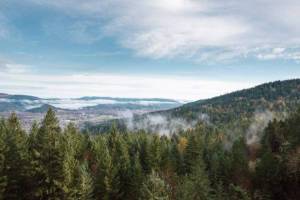Bend, Oregon at a Glance Guide

Some thirty years ago, Bend was a sleepy little mill town in the high desert of Central Oregon. So what’s fueled its remarkable transformation since then?
In a sentence, stunningly beautiful scenery and completely awesome outdoor recreation. From hiking, snowboarding, mountain biking, golf and even spelunking to world-class fly-fishing and rock-climbing, the Bend area literally has it all. Heck, there’s even a human-made whitewater kayaking and river-surfing course in the middle of town. Having more micro-breweries per capita than anywhere else in the country doesn’t hurt either.
Peer past this impressive surface though, and there’s even more going on to put Bend over the top. When describing Bend’s vibe, the word “laid-back” comes to mind, but this is not a city of people who just kick back and laze around.
Maybe it’s the mountain air, but Bend is more than anything else a community of people who are active, vibrant, and deeply appreciative of where they are. It’s a cliché, but it’s true: people in Bend work hard and they play hard.
Culturally, it borrows some of the best features of Portland, with music and culinary scenes rivaling those of much larger cities. In particular, the Old Mill District is home to amazing restaurants, and with extensive shopping and an old-time movie theater, it’s a hot spot for tourists and adventurers drawn to Bend from all over the world. The nearby Les Schwab Ampitheater features world-famous musical acts with superb acoustics and views of the Deschutes River.
One thing needs to be admitted: Bend’s public transportation is not up to snuff. But it more than makes up for it with supremely walkable and bikable neighborhoods. The Deschutes features over 12 miles of both paved and unpaved trail, and for those drawn to the water, there are long stretches of intertube-friendly river, perfect for a hot summer day. There’s a lot here for canine companions to enjoy too: In 2012, Bend was rated the country’s “Dog Friendliest City.”
Naturally, Bend has a ton of jobs in the outdoors industry, but the medical and tourism industries are also booming. With the recent opening of OSU Cascades, a satellite campus of Oregon State University, higher education is also a growing presence.
And if you’re a beer brewer—or a kombucha brewer for that matter—needless to say, your skills could be in high demand. Don’t just believe the hype though. Come get a sense for yourself of what the Bend vibe is all about.
Looking for just the basic facts? Here’s a rundown:
Bend, Oregon Population
How far is Bend, Oregon from Portland, Oregon, Boise, Idaho, and other cities?
Bend is the seat of Deschutes County, which includes the cities of Sisters to the west, Redmond to the north, La Pine to the south and the small unincorporated community of Brothers to the east along Highway 20.
Outdoor attractions in and around Bend are too many to mention, but we’ll name a few anyway: Mount Bachelor (skiing, snowboarding), the Deschutes River (kayaking, intertubing, fishing), Smith Rock (climbing), the Three Sisters and Mount Jefferson Wilderness (hiking, camping), Sparks Lake (paddleboarding, photography), Phil’s Trail (mountain biking)… We could go on.
Bend, Oregon elevation
Bend, Oregon climate and average weather
Bend averages 158 days of completely clear weather per year and 105 days that are mostly sunny. The average low temperature bottoms out at 23 degrees in January and February, with average highs of 42 degrees during the coldest months. The average high temperature for July and August is 82 degrees, cooling down significantly at night with temperatures dropping into the upper 40s.
Read our full article about Bend weather.




